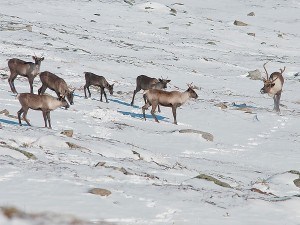
A federal report published by Parks Canada indicates Jasper’s alpine ecosystem is in “poor” but stable condition, raising concerns about the park’s endangered caribou population.
The national report analyzed the condition of eight different ecosystems including forests, freshwater lakes, wetlands and coastal areas within all of Canada’s national parks.
In Jasper, the park’s freshwater ecosystem improved over the past five years and appears to be in “good” shape, while the state of the park’s forests over the same period remains “fair” and unchanged. The report did not analyze the parks’ wetlands, grasslands or glaciers.
According to Parks Canada, each ecosystem is evaluated using a series of five measures.
“Our national parks are part of larger ecosystems that are vulnerable to the changes happening to our environment, such as fragmentation, declining biodiversity and climate change, that in turn influence the state of park ecosystems,” wrote Steve Young, a communications officer with Parks Canada.
“Caribou and whitebark pine, both species-at-risk in Canada, are measures Jasper National Park uses to report on the condition of the alpine ecosystem (or tundra) indicator. While the condition of whitebark pine is fair, the caribou population is in poor condition, leaving the park’s state of alpine indicator poor, but stable.”
According to Young, Parks Canada also collects data on three additional measures, including alpine extent, alpine birds, and glaciers to evaluate the condition of the alpine.
The agency said it intends to collect enough data on these three additional measures in the next state of the park report, which will provide a more comprehensive assessment about the park’s alpine.
Alison Ronson, executive director for the Canadian Parks and Wilderness Society (CPAWS), said she was pleased to see the report, but noted it’s the first report published on the state of Canada’s national parks since 2011. Under legislation Parks Canada is supposed to release a report every two years.
“This is a good first step back towards transparency and accountability of Parks Canada in achieving its first mandate–to protect and manage our parks for ecological integrity,” wrote Ronson.
“Unfortunately, the state of parks reports for individual parks are no longer available, so it is difficult to speak to changes in the ecosystem of individual parks such as Jasper.”
In light of the report, she said CPAWS is particularly concerned about the impact faltering ecosystems have on sensitive species, such as grizzly bears and the park’s dwindling caribou herds.
“Our hope is that the park will make decisions based on conservation principles in order to ensure that habitat for sensitive species such as caribou and grizzly bear move from “fair” to “good” in the near future,” wrote Ronson.
Jill Seaton, chair of the Jasper Environmental Association, said she was alarmed about the state of the park’s alpine.
“Jasper is the only park that has poor alpine conditions,” said Seaton, adding she too is concerned about what this means for the park’s caribou.
The 58-page report, State of Canada’s Natural and Cultural Heritage Places, was tabled in the House of Commons in mid-December.
Besides rating ecosystems in Canada’s national parks, it also included a broader look at species at risk, asset management, cultural and historical resources as well as visitation.
The report found that 29 of the 41 national parks and reserves had at least one ecosystem rated as “fair” or “poor.” Twelve of the parks or reserves had all of the areas rated as “good.” Overall, the ratings are an improvement from 2011.
“Over 90 per cent of national park ecosystems being measured are either stable or improving and there are more ecosystems improving than are declining,” wrote Young.
Paul Clarke
[email protected]
